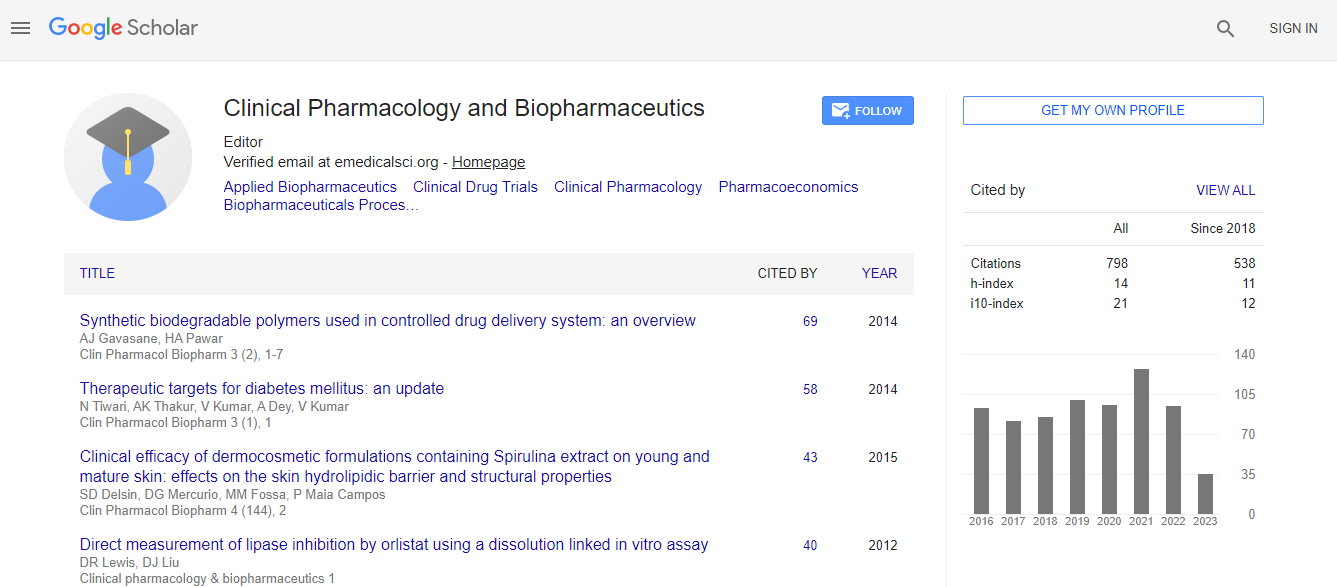Our Group organises 3000+ Global Conferenceseries Events every year across USA, Europe & Asia with support from 1000 more scientific Societies and Publishes 700+ Open Access Journals which contains over 50000 eminent personalities, reputed scientists as editorial board members.
Open Access Journals gaining more Readers and Citations
700 Journals and 15,000,000 Readers Each Journal is getting 25,000+ Readers
Google Scholar citation report
Citations : 1089
Clinical Pharmacology & Biopharmaceutics received 1089 citations as per Google Scholar report
Clinical Pharmacology & Biopharmaceutics peer review process verified at publons
Indexed In
- CAS Source Index (CASSI)
- Index Copernicus
- Google Scholar
- Sherpa Romeo
- Genamics JournalSeek
- RefSeek
- Hamdard University
- EBSCO A-Z
- OCLC- WorldCat
- Publons
- Euro Pub
- ICMJE
Useful Links
Recommended Journals
Related Subjects
Share This Page
Drug delivery to the brain using nanoparticles: A new therapeutic platform
International Conference and Expo on Biopharmaceutics
Jorg Kreuter
Goethe-Universit├?┬Ąt, Germany
Posters-Accepted Abstracts: Clin Pharmacol Biopharm
Abstract
The blood-brain barrier (BBB) represents an insurmountable obstacle for the delivery of a large number of drugs to the central nervous system (CNS). One of the possibilities to overcome this barrier is drug delivery to the brain using nanoparticles. Drugs that have been transported into the brain and led to a pharmacological effect after intravenous injection using this carrier include the hexapeptide dalargin, the dipeptide kyotorphin, loperamide, tubocurarine, doxorubicin, and the NMDA receptor antagonists MRZ 2/576 and MRZ 2/596. To achieve a significant transport across the blood-brain barrier the coating of the nanoparticles with polysorbate 80 (Tween├?┬« 80) was a key factor. Experiments with the extremely aggressive glioblastoma 101/8 transplanted intracranially showed a long term survival for 6 months of up to 40% of the rats after intravenous injection of the polysorbate 80-coated nanoparticle preparation. The surviving animals showed a total remission by histological investigation. Untreated controls died within 10-20 days, doxorubicin controls and uncoated doxorubicin nanoparticle groups died between 10-50 days. The cardiac and testicular toxicity of doxorubicin was very significantly reduced by binding the drug to poly (butyl cyanoacrylate) and even more considerably by binding to human serum albumin nanoparticles. Indication of short-term neurotoxicity, such as increased apoptosis in areas distant from the tumor, increased expression of GFAP or ezrin on distant astrocytes or degenerative morphological changes of neurons were entirely absent. The mechanism of the drug transport across the blood-brain barrier with the nanoparticles appears to be endocytotic uptake by the brain capillary endothelial cells. After injection of the nanoparticles, apolipoproteins A-I or E adsorb on the particles surface promoting the interaction with receptors on the endothelial cells followed by transcytosis.Biography
Email: Kreuter@em.uni-frankfurt.de

 Spanish
Spanish  Chinese
Chinese  Russian
Russian  German
German  French
French  Japanese
Japanese  Portuguese
Portuguese  Hindi
Hindi 
